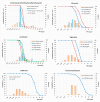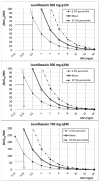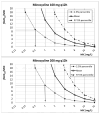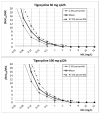Optimizing Antibiotic Therapy for Stenotrophomonas maltophilia Infections in Critically Ill Patients: A Pharmacokinetic/Pharmacodynamic Approach
- PMID: 38927219
- PMCID: PMC11201243
- DOI: 10.3390/antibiotics13060553
Optimizing Antibiotic Therapy for Stenotrophomonas maltophilia Infections in Critically Ill Patients: A Pharmacokinetic/Pharmacodynamic Approach
Abstract
Stenotrophomonas maltophilia is an opportunistic, multidrug-resistant non-fermentative Gram-negative bacillus, posing a significant challenge in clinical treatment due to its numerous intrinsic and acquired resistance mechanisms. This study aimed to evaluate the adequacy of antibiotics used for the treatment of S. maltophilia infections in critically ill patients using a pharmacokinetic/pharmacodynamic (PK/PD) approach. The antibiotics studied included cotrimoxazole, levofloxacin, minocycline, tigecycline, cefiderocol, and the new combination aztreonam/avibactam, which is not yet approved. By Monte Carlo simulations, the probability of target attainment (PTA), the PK/PD breakpoints, and the cumulative fraction of response (CFR) were estimated. PK parameters and MIC distributions were sourced from the literature, the European Committee on Antimicrobial Susceptibility Testing (EUCAST), and the SENTRY Antimicrobial Surveillance Program collection. Cefiderocol 2 g q8h, minocycline 200 mg q12h, tigecycline 100 mg q12h, and aztreonam/avibactam 1500/500 mg q6h were the best options to treat empirically infections due to S. maltophilia. Cotrimoxazole provided a higher probability of treatment success for the U.S. isolates than for European isolates. For all antibiotics, discrepancies between the PK/PD breakpoints and the clinical breakpoints defined by EUCAST (or the ECOFF) and CLSI were detected.
Keywords: PK/PD; Stenotrophomonas maltophilia; aztreonam/avibactam; cefiderocol; cotrimoxazole; levofloxacin; minocycline; tigecycline.
Conflict of interest statement
The authors declare no conflicts of interest.
Figures







References
-
- Terlizzi V., Tomaselli M., Giacomini G., Dalpiaz I., Chiappini E. Stenotrophomonas maltophilia in people with Cystic Fibrosis: A systematic review of prevalence, risk factors and management. Eur. J. Clin. Microbiol. Infect. Dis. 2023;42:1285–1296. doi: 10.1007/s10096-023-04648-z. - DOI - PMC - PubMed
-
- Tamma P.D., Aitken S.L., Bonomo R.A., Mathers A.J., van Duin D., Clancy C.J. Infectious Diseases Society of America Guidance on the Treatment of AmpC β-Lactamase-Producing Enterobacterales, Carbapenem-Resistant Acinetobacter baumannii, and Stenotrophomonas maltophilia Infections. Clin. Infect. Dis. 2022;74:2089–2114. doi: 10.1093/cid/ciab1013. - DOI - PubMed
Grants and funding
LinkOut - more resources
Full Text Sources

